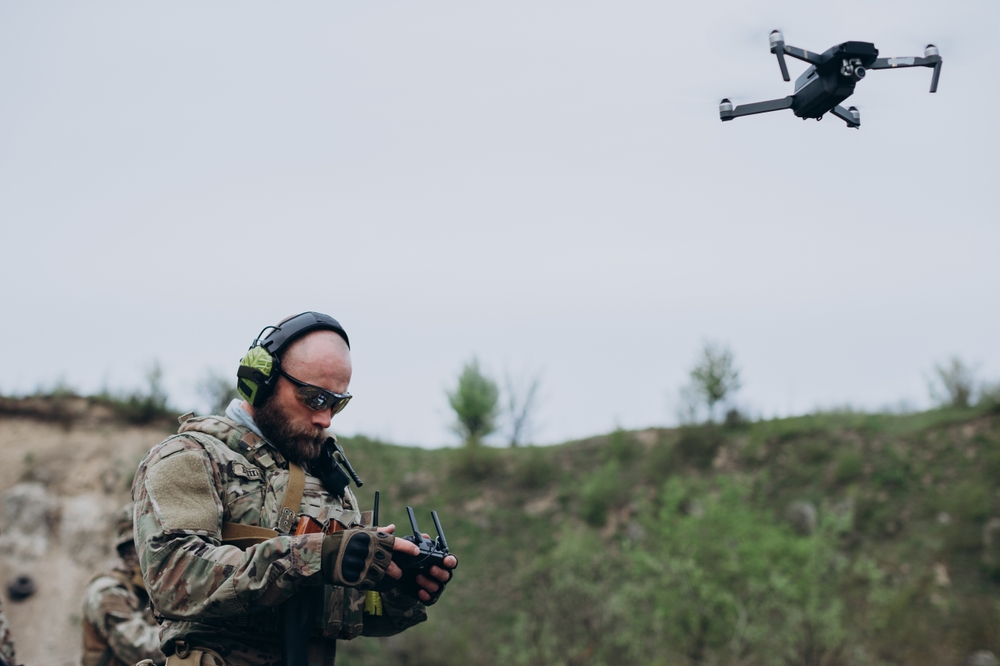Ukraine has become a proving ground for the future of warfare, particularly in the integration of Artificial Intelligence (AI) and drones on the battlefield. With up to a million Unmanned Aerial Vehicles (UAVs) set to be deployed this year, the conflict has rapidly advanced the use of AI in enhancing the effectiveness of these aerial systems. A recent analysis by David Kirichenko, shared in the Kyiv Post and Henry Jackson Society, highlights the pivotal role AI is playing in increasing the precision and capabilities of Ukraine’s drones.
AI Boosts Drone Precision and Success
According to reports from TIME magazine and the UK’s Forces News, the introduction of AI has dramatically improved the hit rate of Ukrainian drones, increasing it from less than 50 percent in 2023 to nearly 80 percent this year. A major contributor to this success has been the U.S.-based company Palantir, described by TIME as the “AI arms dealer of the 21st century,” whose software has revolutionized drone operations in Ukraine.
One example of this technological leap is the SAKER reconnaissance drone, which is equipped with Palantir’s AI software. The SAKER can independently identify various targets, including personnel, tanks, and armored vehicles, and feed the data back to command centers for real-time decision-making. This AI-driven system has not only improved the drones’ ability to detect the enemy but also enhanced their precision by learning to recognize Russian soldiers by their uniforms, weapons, and even their movements.
This machine learning capability has proven critical on the battlefield, where traditional methods of drone navigation have become vulnerable to electronic warfare (EW) countermeasures. With the SAKER’s inertial guidance system, which does not rely on GPS, the drones are much less susceptible to jamming, providing Ukraine with a significant edge in combat scenarios.
Palantir AI Elevates Ukraine’s UAV Strike Rate
Reports from the battlefield suggest that before the adoption of AI, newly trained UAV pilots were achieving success rates as low as 10 percent, while even experienced operators struggled to exceed 50 percent. However, with Palantir’s AI now powering nearly all of Ukraine’s drones used for artillery targeting, the hit rate has surged to nearly 80 percent. This leap in effectiveness underscores the transformative impact AI has had on the conflict, allowing Ukraine to counter Russia’s numerical superiority with smarter, more efficient operations.
Palantir’s software collates data from multiple sources, including drones, human intelligence, radar, and thermal imaging, to detect movement and artillery fire on the battlefield. The AI system processes this information and provides military commanders with various targeting options, allowing for more precise strikes against enemy forces.
The Ethical Dilemmas of AI on the Battlefield
While AI has provided Ukraine with a strategic advantage, it has also raised ethical concerns. Kirichenko warns that the increasing autonomy of AI-equipped drones poses potential risks. AI systems may not always be capable of interpreting the complex nuances of the battlefield in the way a human operator can, leading to possible misjudgments. This concern becomes even more pressing when considering the ability of AI to identify targets based on movement, even when soldiers are out of uniform.
Kirichenko highlights a critical question: could AI distinguish between combatants and civilians, especially in cases where Russian soldiers are not in uniform? While Ukrainian and Western forces might exercise caution, he argues that Russia’s tactics in the conflict suggest they may not be as discerning, raising moral implications about the future use of AI in warfare.
The Future of Warfare: Algorithms Over Armor
Despite these concerns, the rapid development of AI technology in Ukraine’s military operations suggests that the use of AI in warfare will only continue to grow. As Kirichenko notes, Ukraine’s ability to leverage advanced technology to counter Russia’s larger forces has defied conventional expectations. This AI-driven evolution, he argues, is essential for Ukraine to maintain its edge in the conflict.
As Forces News succinctly puts it, “The war of the future is likely to be as much about algorithms as armor.” With AI playing an increasingly dominant role in modern military strategy, Ukraine’s conflict serves as a case study in how technology can reshape the battlefield, offering both advantages and ethical challenges for the future of warfare.


